Canon Wide Angle Zooms comparison/review: 16-35/f2.8 L II v. 17-40/f4 L
14 Comments
Canon makes two wide-angle zooms for full-frame cameras. Both are L-lenses, reasonably well-built, with fast USM autofocusing, a non-rotating front element, and an environmental rubber seal. The 17-40/f4L was introduced in 2003. The 16-35/f2.8 L II, released in 2007, replaced the 16-35/f2.8L of 2001, which itself replaced the 17-35/f2.8L of 1996. I have not used the 2001 lens, but I can say that both current lenses are a significant improvement over the 1996 lens.
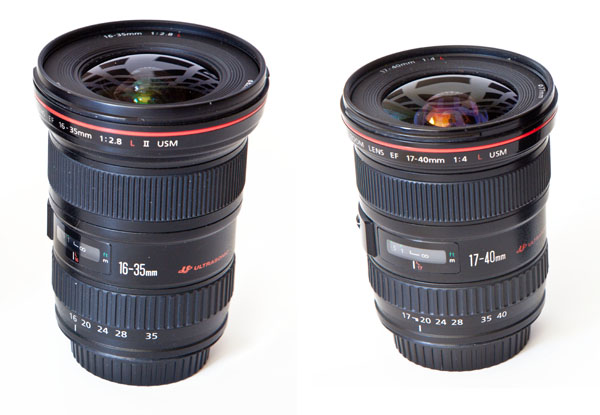
The 16-35/f2.8 is twice the price as the 17-40/f4, and the weight difference, although small, is noticeable on a body such as the Canon 5D. The 16-25/f2.8 also requires uncommon 82mm filters, while the 77mm filters for the 17-40/f4 can be shared with the 24-105, 24-70, 100-400, 70-200/f2.8, amongst others. Is there any benefit, besides the faster maximum aperture, and what is it useful for ?
Based on Imatest testing on a full-frame 5D mk2 (one of the most reliable methods to measure lens performance, see this post for details) both lenses yield comparable image quality, with no lens besting the other consistently across the focal range. Contrarily to what has been reported by others (whom I suspect got sub-par copies of the 17-40) I did not find any definitive advantage for the 16-35. Please note that I have tested 3 different samples of the 16-35, finding the sample-to-sample variation to be, for once, quite small. Full results for focals 17mm, 20mm, 24mm, 28mm, and 35mm are below. Click on any graph to enlarge.
The 16-35 has a slight advantage at short focal lengths, mostly in terms of edge sharpness, while at the longer focal lengths, the 17-40 has a slight advantage. I do not consider those differences to be that significant. Both those lenses yield good center sharpness, but are not so good near the edges, in particular when used at f2.8-f4.
Because in the past I have almost always used the lens stopped down to at least f8 for depth of field and better sharpness, the f2.8 aperture wasn’t that useful for me. Even if what you are after is out-of-focus blur, not much is generated by the additional f-stop, since the focals are so wide. Therefore, I think that for the majority of photographers and situations, the 17-40/f4 will do just as fine.
One specialized situation has came up recently, as I got more interested in night photography with star fields. In photographing stars, one is almost always using the highest acceptable ISO, as stars are faint light sources. Shutter speeds are limited by the movement of the earth. A shutter speed longer than 30s will cause stars to be renders as streaks rather than points. This leaves no choice but using the widest aperture available, and one f-stops makes a big difference here. If point stars are not involved, the 17-40/f4 might otherwise be the better choice for night photography, because its simpler construction make it more resistant to flare.
The results at f2.8 are sufficiently poor to warrant using a fixed focal length instead. I have tested, amongst others, the Canon 24/f1.4 II and the famed Zeiss Distagon 21/f2.8, which are both better at wide apertures, but this will be the subject for a different post. If one is carrying such a lens, the f2.8 aperture of the zoom becomes kind of useless, and therefore the 17-40/f4 would be a better choice.
There are situations (such as backpacking or light travel), where one would not wish to carry a separate lens just for a few night shots. Some photographers also do not want to own several wide-angle lenses. In my opinion, the 16-35/f2.8 is mostly useful for those situations when a single fast and versatile lens is required. In other words, get the 16-35/f2.8 if you plan to shoot wide-open, and it will be your only wide-angle lens, otherwise get the 17-40/f4.
Summary:
| 16-35mm f/2.8 II | 17-40mm f4 | |
|---|---|---|
| Maximum aperture | f2.8 extra stop mostly useful for night astro photography, brighter view, easier to focus in live view, faster AF | f4.0 adequate for most applications, since lens is likely to be used stopped down for DOF and optical performance |
| Focal range | 16mm slightly, but noticeably shorter than 17mm | 35mm-40mm likely covered by other lenses |
| Close Focus | 0.9 ft./0.28m, 0.22x magnification | 0.9 ft./0.28m, 0.24x magnification | Sharpness | Slight edge < 24mm, see graphs | Slight edge > 28mm , see graphs |
| Distortion |
16mm: 3% (barrel) 20mm: 0.5% (barrel) 24mm: 0.6% (pincushion) 28mm: 1.2% (pincushion) 35mm: 1.4% (pincushion) |
16mm: 2.8% (barrel) 20mm: 1.5% (barrel) 24mm: 0.3% (pincushion) 28mm: 0.5% (pincushion) 35mm: 1.1% (pincushion) |
| Chromatic Aberation | comparable (0.06/0.05/0.06/0.04/0.02) | comparable (0.06/0.05/0.04/0.03/0.02) |
| Other | More resistant to flare | |
| Lens construction | 16 elements, 12 groups | 12 elements, 9 groups |
| Filter size | 82mm | 77mm |
| Size DxL | 3.5 x 4.4 in/88 x 111mm | 3.3 x 3.8 in/83 x 96mm |
| Weight | 1.4 lb / 635g | 1 lb / 475g |
| Price (08/2010) |
$1520 @ BH
$1518 @ amazon |
$750 @ BH
$730 @ amazon |
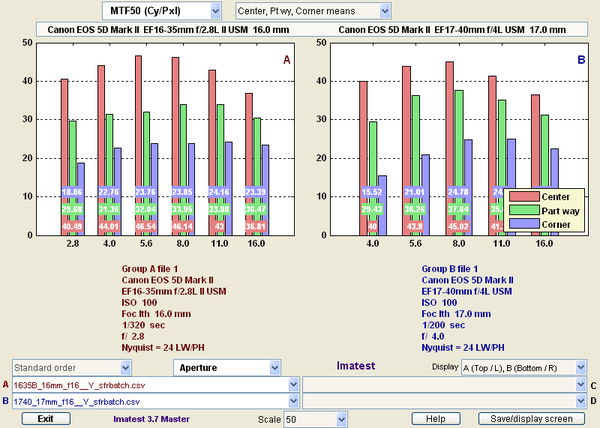
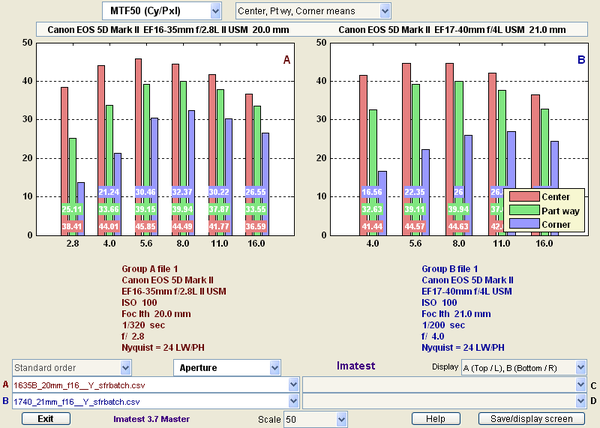
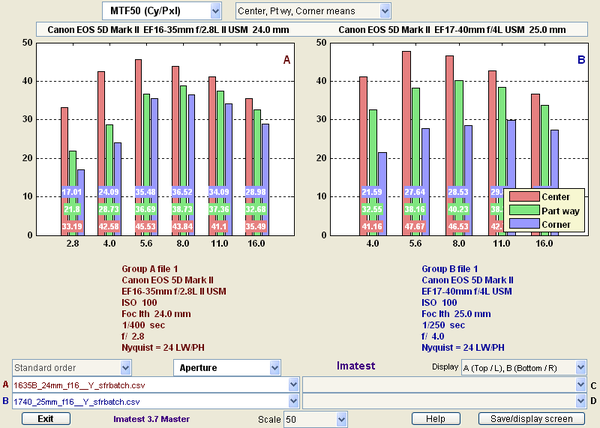
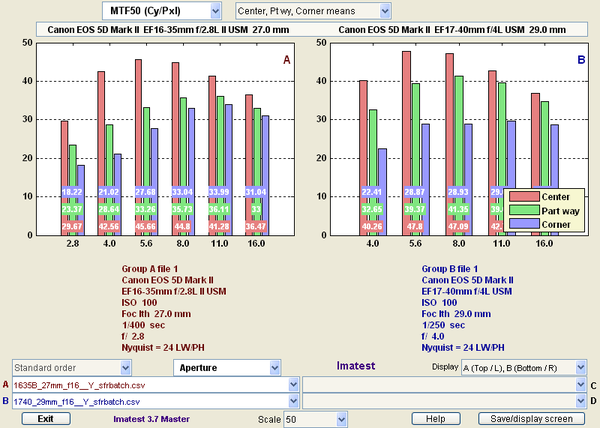
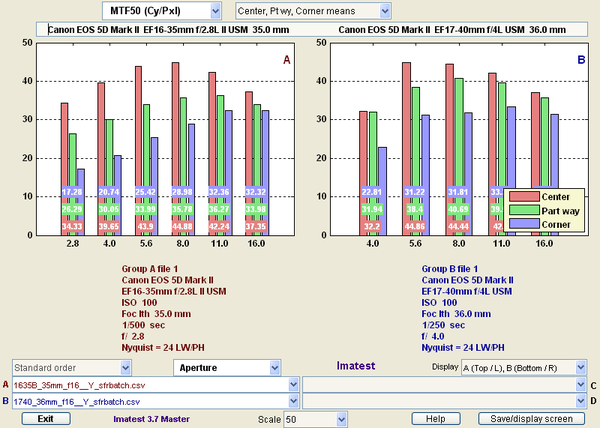


Thanks for posting this thorough review. It further confirms what I have already been telling other photographers the last few years.
Good to read another review on these two. I am more set now on getting the 17-40. Thanks!
Excellent summary and review. I have both of them and use the 17-40 for most nature work and the 16-35 for aurora and other shooting that requires the speed. Backpacking often forces some restraint for gear and weight, and therefore the multiple or overlapping focal lengths get nixed and a bit of compromise leaks in. I’ve been wanting to see a thorough test on these lenses and appreciate your thoughtful review. I look forward to more in the future. Thanks.
Thanks for the very informative comparison I’ve been eyeing a wide angle zoom for some time and this definitely helps to put some things into perspective.
i have to say from my experience with a 2.8 zoom lens that they are bigger heavier costlier and not so much better . its just one aperture and with wideangle lenses yu dont get that blureffect really unless yu get close.good for documentations weddings action.i would use a fixed lens for landscapes they are very much smaller lighter sharper.yu can put it in your pocket too.a 15mm and a 28mm are the 2 lenses i would use.and a 135mm (300mm for tele if you want to carry it.)reduce the weight as much as you can and improve the quality ! 17-40 would be the one for me and its half the price too !
greetings
dietmar
QT, this is in line with my impression of the two lenses. Especially for landscape, architecture (if you aren’t using a T/S), and similar work typically done stopped down from the tripod, there seems to be essentially no good reason to spend the extra money or carry the extra weight (or fuss with an odd-sized filter) of the 16-35.
You are right that this comparison question comes up a lot. I’ve developed a more or less stock answer for Canon shooters who has about this. It goes more or less like this:
The main strength of the 16-35 f/2.8 is its performance at the very largest apertures on full frame cameras, making it a good choice for those shooting FF who need to work hand-held in low light conditions. It provides no advantages at smaller apertures.
The main strength of the 17-40 (aside from lower price and weight) is its stopped down performance on full frame cameras, making it ideal for those shooting landscape, architecture and similar subjects from the tripod with an ultra-wide angle zoom.
For those shooting cropped sensor cameras, I believe that the EFS 17-55mm f/2.8 IS is probably a better choice than either of the L lenses, based on my reading of test results and the feature set of this lens.
Thanks for your post.
Dan
QT:
Thanks for your lens comparison. I too, have always found the 17-40 to work beautifully for landscape photography. I have recently lusted after the 24mm f/1.4II for star photography – but I’ve been waiting since I haven’t seen a good review of that lens – and the “consumer reviews” that are often readily available frequently are biased by poor technique or poor copies of a lens. I really appreciate your balanced perspective in the comparison of the 16-35 and the 17-40!
Thanks to everybody for comments. The fact that the optical performance of the two lenses is comparable is not a given. For instance Lloyd Chambers writes in the well-regarded gear review site diglloyd.com that he the 16-35/f2.8 II is “generally superior optically” to the 17-40.
I mentioned in the summary the focusing advantage of the f2.8 lens, but this is not something which is amenable to testing with numerical results, unlike some other aspects of lens performance, hence I did not elaborate further. However, my observation has been that the focusing advantage resides not so much in speed as in accuracy. It is easier to focus critically (especially with live view) a f2.8 lens than a f4 lens. The autofocus is also more precise, since many cross-sensors require f2.8. This may make it possible to obtain more consistently well focused images.
Richard, I have tested the 24/f1.4II specifically for star photography. In short, I was disappointed by the coma control at f1.4 and f2.0, but I have to see if there are better options out there. I had planned to write more about it, but the poll that I posted shows a general lack of interest in gear reviews on this blog.
The graphs pretty well clearly show that the 16-35mm is superior at f4 than the 17-40mm through the majority of its range. So, if you shoot at this aperture, you may want the faster lens. Even stopped down at f8 the 16-35mm shows some MTF advantages (except at the longer end). Whether this is noticeable is another thing, but it does seems to be there.
I have owned both lenses – now I just have the 16-35 2.8 II
The 16-35 has way better colors and sharpness! (you basicly cant shoot the 17-40 at first two stops and not use USM in PSD) – it´s sharper at 2.8 than 17-40 is at 4.0 and 5.6…
To me that means the world – and is why I dont own the 17-40 anymore.
In regards to autofocus accuracy, while true that autofocus is more accurate on 2.8 lens generally, for a wide angle this simply doesn’t matter much. At 17mm and f5.6 you have a depth of field of 1.5 meters to infinity. It’s hard to miss focus with such a huge depth of field.
Ohh and this article only deals with the sharpness. It would be nice to have a comparison of colour and contrast.
QT,
Thanks for putting this together. It was really helpful in my research for a deciding upon a replacement to the Tokina 11-16 / 2.8 for a transition from an APS-C to a full frame.
All things (price, weight, consistent filter size) points towards the 17-40. The additional f-stop will be missed, but honestly it was rarely used to begin with.
Consider the Tokina 16-28mm 2.8 then, its the only one that will live up to the Tokina 11-16 f2.8. And the Tokina 16-28mm is sharper than any of the Canon’s however it can not use a filter.
I haven’t tried those, but I am not surprised they perform better than the Canons, seeing how they compare to the Nikon 14-24/2.8